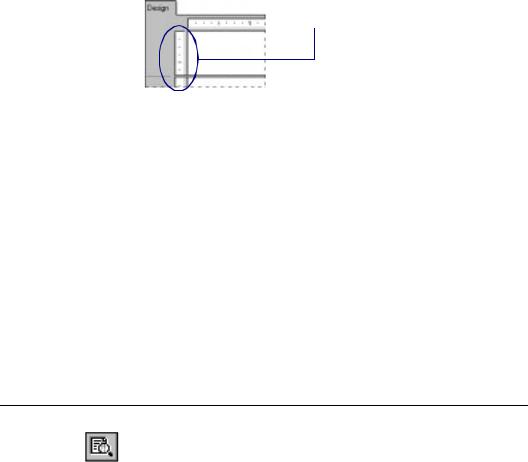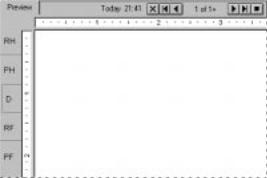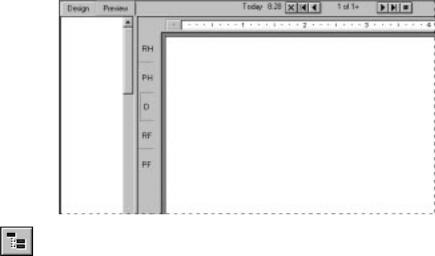
- •Welcome to Seagate Crystal Reports
- •Welcome
- •Two kinds of Hands-On tutorials
- •Command, button, key, and control conventions
- •Using Seagate Crystal Reports documentation
- •Seagate Crystal Reports online Help features
- •If you need more help...
- •Installation Requirements
- •Installing Seagate Crystal Reports
- •Installing on a network workstation
- •Upgrading from a previous version
- •Quick Start
- •Subreports expand report usefulness
- •Query Designer adds ad-hoc querying capabilities
- •Parameter fields mean multi-purpose reports
- •Text objects give you text with intelligence
- •Preprinted-form reports easier than ever
- •More powerful formulas extend your capabilities
- •Web solution serves up variety of online reports
- •HTML exporting simplifies Web activities
- •New database support improves data access
- •Running totals made easy
- •Smart Navigation
- •Learning Seagate Crystal Reports
- •User’s Guide
- •Online Help
- •Books Online
- •Sample Reports
- •Glossary
- •Sample Data - CRAZE.MDB
- •Suggested learning paths
- •The application window
- •Menu bar
- •Standard toolbar
- •Supplementary toolbar
- •Format bar
- •Status bar
- •Shortcut menus
- •Cursors
- •Design Tab
- •Preview Tab
- •Other fundamentals
- •HANDS-ON (Report Design Environment)
- •How to add, delete, and move guidelines
- •How to move and position objects using guidelines
- •How to turn the grid on/off
- •How to zoom your report in and out
- •How to undo/redo activities
- •How to drill down on summarized data
- •HANDS-ON (Sections and Areas)
- •How to add, delete, move, and merge sections
- •How to split and resize sections
- •Basic report design
- •How to design a prototype
- •Concepts in reporting
- •Beyond basic reports
- •HANDS-ON (Report Creation and Design)
- •How to select data and begin creating a report
- •How to add and link multiple tables
- •How to insert database fields
- •How to insert special fields
- •How to insert a page n of N field
- •How to insert text objects
- •How to use a database field in a text object
- •How to insert a picture
- •How to select, move, and resize objects
- •How to hide parts of the report
- •HANDS-ON (Finishing Your Report)
- •How to insert page headers and footers
- •How to add a title page to your report
- •How to add summary information to your report
- •Printing considerations
- •Design solutions for printing/distributing
- •Report creation checklist for distributed reports
- •Updating printer drivers
- •Report distribution
- •HANDS-ON (Distributing Your Report)
- •How to export reports
- •How to fax a report
- •How to request reports from a web browser
- •How to specify parameter field values
- •How to log on to a database
- •How to view plain HTML reports
- •Overview
- •Getting started
- •Record Selection
- •Grouping and sorting
- •Completing the report
- •Introduction
- •Working with Arbor Essbase data
- •HANDS-ON (Reporting on OLAP data)
- •How to create a cross-tab with Essbase data
- •Using multiple sections in reports
- •HANDS-ON (Multiple Section Reports)
- •How to work with text objects
- •How to create a form letter using a text object
- •How to format objects conditionally
- •How to print conditional messages in form letters
- •How to alternate background colors for rows
- •How to eliminate blank lines
- •How to add blank lines conditionally
- •Formatting concepts
- •Absolute formatting
- •Types of formatting properties
- •Conditional formatting
- •HANDS-ON (Absolute Formatting)
- •How to add color, shading, and borders
- •How to add/edit lines and boxes
- •How to change margins
- •How to add/delete white space between rows
- •How to set page orientation and paper size
- •HANDS-ON (Conditional Formatting)
- •How to flag values that meet certain conditions
- •Record selection
- •Group selection
- •Record selection formula templates
- •HANDS-ON (Record and Group Selection)
- •How to create a record or group selection formula
- •How to use record/group selection templates
- •How to select the top or bottom N groups
- •Sorting, Grouping, and Totalling Overview
- •Creating custom groups
- •HANDS-ON (Sorting, Grouping, and Totalling)
- •How to do a single field sort
- •How to do a multiple field sort
- •How to group data
- •How to sort records within groups
- •How to summarize grouped data
- •How to subtotal grouped data
- •How to sort based on summarized group values
- •How to create multiple levels of subtotals
- •How to group data in intervals
- •How to calculate a percentage of the grand total
- •How to create group headers
- •What are formulas?
- •Other formula conventions
- •Formula syntax
- •How formulas are evaluated - Order of precedence
- •HANDS-ON (Formulas 101)
- •How to insert a formula in your report
- •How to delete formulas from your report
- •How to copy formulas from online Help
- •How to copy formulas from one report to another
- •How to create if-then-else formulas
- •How to format text with formulas
- •How to use variables in formulas
- •How to declare a variable
- •How to assign a value to a variable
- •How to conditionally assign values to variables
- •How to use an array in a formula
- •How to use a range in a formula
- •How to use semicolons in formulas
- •How to fine tune group selection formulas
- •How to fine tune record selection formulas
- •How to debug a formula
- •Introduction
- •HANDS-ON (Advanced Totalling)
- •How to maintain running totals in a list
- •How to subtotal running totals within groups
- •How to subtotal without grouping
- •How to subtotal true A to B, A to C reports
- •Parameter field objects overview
- •Multiple parameter fields
- •Parameter field considerations
- •HANDS-ON (Parameter Field Objects)
- •How to create a parameter field
- •How to use a parameter field in a formula
- •How to respond to parameter field prompts
- •How to use wildcards with parameter fields
- •How to set a report title using parameter fields
- •How to set sort order using parameter fields
- •Graphing Overview
- •Choosing a graph or chart type
- •Where to place your graph
- •Data you can graph on
- •Before you create your graph
- •HANDS-ON (Graphing)
- •How to graph on a summary or subtotal field
- •How to graph on a details field
- •How to graph on a formula field
- •How to graph on cross-tab summaries
- •How to edit graphs using PGEditor
- •How to use the underlay feature with graphs
- •OLE Objects Overview
- •Inserting OLE objects in your reports
- •Linked vs. Embedded Objects
- •The dynamic OLE menu commands
- •OLE and the Picture command
- •General OLE considerations
- •HANDS-ON (OLE Objects)
- •How OLE objects are represented in your report
- •How to use OLE - General Overview Tutorial
- •How to insert a graphic/picture as an OLE object
- •What are subreports?
- •Unlinked vs. linked subreports
- •How subreport linking works
- •HANDS-ON (Subreports)
- •How to insert a subreport
- •How to preview your subreport
- •How to combine unrelated reports using subreports
- •How to use subreports with unlinkable data
- •Cross-tab overview
- •Cross-tab components
- •HANDS-ON (Cross-Tab Objects)
- •How to create a cross-tab object
- •How to format a cross-tab
- •How to print cross-tabs that span multiple pages
- •The Crystal Query Designer
- •HANDS-ON (Queries)
- •How to create a new query
- •How to add tables to a query
- •How to link tables and specify a join type
- •How to add fields to a query
- •How to identify unique values in a query
- •How to summarize data with aggregate functions
- •How to sort records according to field values
- •How to specify records to be included in a query
- •How to select groups to be included in a query
- •How to create an SQL expression
- •How to create a query from another Crystal Query
- •How to select a query for a report
- •How to use a parameter field in a query
- •Dictionaries Overview
- •HANDS-ON (Dictionaries)
- •How to create a new dictionary
- •How to add a data file
- •How to open an SQL or ODBC data source
- •How to link multiple tables
- •How to select tables and fields for users
- •How to add/create formulas
- •How to move fields/field headings within the list
- •How to update the location of a database table
- •How to add a new field heading
- •How to add Help text
- •How to add a graphic
- •How to create sample data for users to browse
- •How to edit an existing dictionary
- •How to convert a 3.x or 4.x dictionary file
- •How to select a dictionary for a report
- •Databases Overview
- •For additional information
- •HANDS-ON (Working With Databases)
- •How to open Access queries through DAO
- •How to open Access queries through ODBC
- •How to open Access parameter queries
- •How to set up an ODBC data source
- •How to check settings for an ODBC data source
- •How to log on to an ODBC data source
- •How to add an ODBC database table to a report
- •How to log on to MS SQL Server via ODBC
- •How to log off an ODBC data source
- •How to set up an A to B, A to C link
- •How to edit an SQL query
- •How to use an ACT! database
- •How to open the NT Event Log
- •Introduction
- •Four types of data
- •Direct access database files
- •ODBC data sources
- •Crystal Query Designer files
- •Crystal Dictionary files
- •Multi-pass reporting
- •Product support
- •Web support
- •E-mail support
- •Fax support
- •Telephone support
- •Extended technical support policy
- •Product registration
- •Product return policy
- •Product replacement policy
- •Glossary

Section ruler.
Other Design Tab capabilities
Preview Tab
Whenever you add a new section, the program creates a ruler for that section. See How to add, delete, move, and merge sections, Page 89.
There are several other capabilities built into the Design Tab.
●You can resize a section by dragging its boundary. See How to split and resize sections, Page 92.
●You can split a section (create two sections from one) by clicking its left boundary. See How to split and resize sections, Page 92.
●You can add horizontal and vertical guidelines by clicking the rulers. See How to add, delete, and move guidelines, Page 82.
●You can zoom in and out on your report at any magnification from 25% to 400% of the original size. See
How to zoom your report in and out, Page 86.
When you want to preview your report before printing, click the PRINT PREVIEW button on the standard toolbar.
The program gathers the data, makes the necessary calculations, and displays the report in the Preview Tab on electronic “paper.” With the data in place, you can review the spacing and formatting of your report and see the actual results of all your summaries, formula calculations, and record and group selections.
In true WYSIWYG (What You See Is What You Get) fashion, you can work directly on this live data, fine tuning it until the report has the exact look you want.
The program works with data in the following manner:
72 |
Seagate Crystal Reports User’s Guide |

●The first time the Preview Tab is used, it retrieves data from your underlying data source(s) and saves it with the report (unless you have set up the program not to save data).
●From that point on, the program uses the saved data whenever you preview the report unless you specifically refresh it or add a field that requires the program to retrieve new data.
Seagate Crystal Reports provides two views for previewing your report:
1.Standard view, and
2.Group Tree view.
Standard view
In standard view, the report is displayed a page at a time. Using the navigation buttons in the Preview Tab, you can move to the beginning or end of the report, or you can move backwards and forward through the report a page at a time. For shorter reports or reports in which you're primarily interested in seeing the “bottom line” totals, standard view provides all of the functionality that you need.
THE DATA AGE INDICATOR
The Data Age indicator indicates the date the data was last refreshed or initially retrieved, whichever is the most recent. If the data was initially retrieved or refreshed today, it indicates the time it happened. Search for Save Data with Report command in Seagate Crystal Reports online Help.
Getting to Know Seagate Crystal Reports |
73 |

Group Tree view
Similarities/
differences from Design Tab
You can toggle the Group Tree view on/off using the TOGGLE GROUP TREE button on the format bar.
The Group Tree view presents a split screen.
●The right pane of the screen displays the report.
●The left pane displays a high level outline of the report, showing the hierarchy of groups and subgroups in a familiar tree format.
When you click the tree node for the group that interests you, the program jumps immediately to the part of the report that contains the information for that group. For longer reports or reports in which you wish to jump back and forth between different groups, the Smart Navigation features of the Group Tree view make your work extremely efficient.
You have the same formatting capabilities in the Preview Tab as you do in the Design Tab. Menus (both menu bar and shortcut menus), the standard and supplementary toolbars, rulers, and the format bar remain active, giving you essentially the same functionality you have when working with a report in the Design Tab. However, when you are making many changes, it is quicker to make the changes in the Design Tab.
●The Design Tab and Preview Tab are tied together internally. Any changes you make in one are reflected in the other.
74 |
Seagate Crystal Reports User’s Guide |
●The Preview Tab has a single vertical ruler at the left of the tab instead of the individual section rulers like the Design Tab. The functionality of the ruler is the same.
●The Preview Tab identifies report sections in the shaded area to the left of the data. With a quick look you can tell which report section the data is printing from. While section names appeared only once in the Design Tab, they print each time a section prints in the Preview Tab.
●The Record counter (see DATA RETRIEVAL INFORMATION, Page 61), the Data Age indicator (see THE DATA AGE INDICATOR, Page 73), and the Page Forward/ Page Back controls (see Preview Tab, Page 72), are all active in the Preview Tab.
●The Preview Tab highlights every value when you select a field whereas only the field frame is highlighted in the Design Tab.
A DIFFERENT FEEL
Working in the Preview Tab has a different feel than working in the Design Tab.
Each field in a database contains dozens, hundreds, or even thousands of values, depending on the number of records in the database. When you place a field in the Design Tab, a single field frame represents all those values. When you highlight the field, sizing handles appear on the frame and the frame changes color.
In the Preview Tab, however, you are working with the actual data. Instead of a field frame representing many field values, the values themselves appear.
●When you highlight a field or formula field value, you are actually selecting every value in the field.
¾The program places a sizing frame around the specific value you select.
¾It highlights every other value from the field.
●Likewise, when you select a summary value, you are actually selecting all of the related summary values.
Getting to Know Seagate Crystal Reports |
75 |
